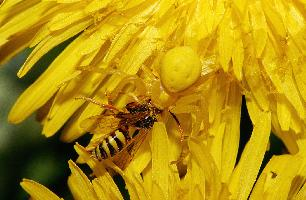
Weights and measures
| Length | from 4 to 10 mm |
|---|
Animal description
The Goldenrod crab spider (Misumena vatia) is a fascinating and visually striking species of spider that belongs to the family Thomisidae, commonly known as crab spiders. This name derives from their crab-like appearance and movements, including the ability to move sideways and backward with remarkable agility. Misumena vatia is particularly well-known for its remarkable ability to change color, a trait that sets it apart from many other spider species and has garnered it considerable attention among both scientists and nature enthusiasts.Adult females of the species are the most visually distinctive, capable of growing up to 10 millimeters in body length, while the males are generally smaller, reaching about 5 millimeters. The females possess a significant ability to change their coloration from white to yellow and vice versa, allowing them to blend seamlessly into their environment. This color change is primarily dependent on the spider's surroundings, specifically the flower it chooses to inhabit, and the process can take a few days to complete. The purpose behind this incredible natural camouflage is to aid in hunting and protection. By blending into the petals of flowers, the goldenrod crab spider can ambush its prey, which often includes insects such as bees and butterflies that are attracted to the flowers for nectar.
The morphology of Misumena vatia is another aspect that fascinates researchers and enthusiasts alike. Their bodies are relatively flat and broad, with the first pair of legs significantly larger and stronger than the rest, which aids in capturing and holding onto their prey. The coloration of their body is not only an adaptation for camouflage but also serves as a warning to potential predators about their toxic nature.
Goldenrod crab spiders do not create webs to catch their prey. Instead, they rely on their camouflage and patience, waiting motionlessly on flowers for unsuspecting insects to approach. Once within reach, they grab their prey with their powerful front legs and immobilize them with a venomous bite.
The habitat of Misumena vatia is primarily among flowers in meadows, gardens, and fields, where they can be found from spring to fall. They have a wide geographical range, being present in North America, Europe, and parts of Asia. Their presence in a garden is often considered beneficial, as they help control the populations of insects that may be harmful to plants.
Reproduction is another interesting aspect of their life cycle. After mating, the female lays eggs on the underside of leaves and guards them until they hatch, showcasing a level of parental care that is not common among many spider species.
In conclusion, the Goldenrod crab spider (Misumena vatia) is a remarkable creature that embodies the incredible adaptability and diversity of life. Its ability to change color for camouflage, combined with its unique hunting strategy and broad habitat range, makes it a subject of great interest and admiration in the natural world.
New photos of animals
Top 10 animals
- Dolphin gull (Leucophaeus scoresbii)
- Diana monkey (Cercopithecus diana)
- Moustached guenon (Cercopithecus cephus)
- Galápagos tortoise (Geochelone nigra complex)
- Stone loach (Barbatula barbatula)
- Japanese macaque (Macaca fuscata)
- Greek tortoise (Testudo graeca)
- Russian tortoise (Testudo horsfieldii)
- Common flying dragon (Draco volans)
- Galápagos penguin (Spheniscus mendiculus)